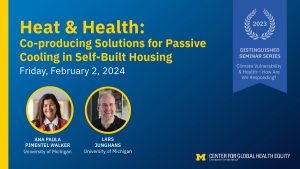Presented By: Center for Global Health Equity
Heat & Health: Co-Producing Solutions for Passive Cooling in Self-Built Housing
Ana Paula Pimentel Walker & Lars Junghans, Taubman College of Architecture and Urban Planning

Climate change is already having dramatic effects on human health and well-being. How are we adapting to these new realities and mitigating health risks for the world’s most vulnerable communities? Join us for the third seminar of the series: Climate Vulnerability & Health — How are we Responding?
In this talk, Dr. Pimentel Walker and Dr. Junghans will explore innovative housing solutions for climate resilience in self-built settlements in São Paulo, Brazil and Bucaramanga, Colombia.
Register: https://myumi.ch/Qqy5E
—
Full description:
Heat is a growing health risk aggravated by expanding urbanization, an increase in high-temperature extremes, and demographic changes. Communities living in precarious settlements are disproportionately vulnerable to extreme heat. Although building techniques to improve indoor thermal comfort can be an adaptation option, we lack design research tailored to the realities of self-built homes. Design research for passive cooling frequently stems from building standards in the Global North. In the Global South, these strategies target middle-class buildings, with higher-end formal construction built by design professionals and engineers.
This pilot project conducted an ethnographic account of auto-construction practices and constraints in two informal and precarious settlements in São Paulo, Brazil, and Bucaramanga, Colombia. The computational simulations identified interventions that theoretically improve occupant thermal comfort by increasing air velocity and lowering indoor temperatures, ultimately reducing heat stress. Our collaborative research in Burkina Faso has already implemented interventions, and it is in the assessment stage. However, are all identified passive cooling strategies equally feasible and responsive to community expectations? Working with community members and their advocacy networks, we plan to co-develop passive cooling strategies that are desirable and achievable, amplifying the voices of low-income residents in the policy agendas for climate and housing justice.
In this talk, Dr. Pimentel Walker and Dr. Junghans will explore innovative housing solutions for climate resilience in self-built settlements in São Paulo, Brazil and Bucaramanga, Colombia.
Register: https://myumi.ch/Qqy5E
—
Full description:
Heat is a growing health risk aggravated by expanding urbanization, an increase in high-temperature extremes, and demographic changes. Communities living in precarious settlements are disproportionately vulnerable to extreme heat. Although building techniques to improve indoor thermal comfort can be an adaptation option, we lack design research tailored to the realities of self-built homes. Design research for passive cooling frequently stems from building standards in the Global North. In the Global South, these strategies target middle-class buildings, with higher-end formal construction built by design professionals and engineers.
This pilot project conducted an ethnographic account of auto-construction practices and constraints in two informal and precarious settlements in São Paulo, Brazil, and Bucaramanga, Colombia. The computational simulations identified interventions that theoretically improve occupant thermal comfort by increasing air velocity and lowering indoor temperatures, ultimately reducing heat stress. Our collaborative research in Burkina Faso has already implemented interventions, and it is in the assessment stage. However, are all identified passive cooling strategies equally feasible and responsive to community expectations? Working with community members and their advocacy networks, we plan to co-develop passive cooling strategies that are desirable and achievable, amplifying the voices of low-income residents in the policy agendas for climate and housing justice.